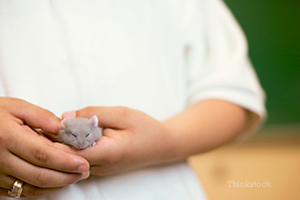
Whether you're a hamster veteran or just welcome a new furball into your home, these tips will help you keep your hamster healthy and happy!
Let your hamster eat well! However, what they eat is just as important as how much they eat. Hamsters like to pick out the tasty fattening food first out of the dish. Often you’ll see the sunflower seeds disappear first, followed by the less fatty (and less tasty) seeds. It’s very important that you provide your hamster with well-balanced food. Just because they love sunflower seeds doesn’t mean that’s all they should eat! Kids like cookies but need their fruits and vegetables, too.
Speaking of fruits and vegetables – hamsters need them too! The best treats for hamsters are foods that are similar to what they might eat in the wild. Fresh (rinsed with water) veggies are good, and examples include carrots, squash, broccoli, cauliflower, cucumber, romaine lettuce, spinach and other greens. Fresh fruits (rinsed in water) are good too, such as apples, pears, bananas, grapes and most berries. But remember never to give any citrus fruits like oranges, limes, lemons or grapefruit. Only give small amounts at a time.
In addition to fresh fruits and veggies, hamsters love whole grain breads and cereals. Also, protein is an important part of a hamster’s diet as well. Plain scrambled or boiled eggs are a nice treat. The thing to remember when fixing your hamsters' dinner is that moderation and variety are very important. Always provide the standard seed and pellet mix daily, and only offer some of these treats in addition to it.
Make your hamster’s bed. Choose your hamster’s bedding carefully. Some times of bedding, such as cedar shavings, can cause skin irritations because of the oils in the cedar chips. Change your hamster’s bedding regularly, and while you’re at it, give his cage a hearty scrub. Also, be sure to rinse his water bottle, as room temperature water can grow algae and acquire bacteria that will make a hamster sick. Your little furball will by much happier (and less stinky) in a clean cage.
Hamsters appreciate spacious and exciting living quarters as much as we do. Your hamster needs space to exercise and keep fit in his own cute way. Paper towel tubes, plain brown boxes and other items are cheap entertainment and provide your hamster with something to chew on regularly. There also many great toys you can buy for your furry friend.
When it comes to cages, you can go with plastic or wire, but be aware that hamsters chew, so you’ll want to keep an eye on your hamster and make sure he isn’t successful in carrying out his own version of “The Great Escape.”
Speaking of chewing, did you know a hamster’s teeth grow like fingernails? Amazingly, hamster teeth never quit growing and they are one of the few furry creatures who are born with a full set of teeth! Hamsters usually take care of their own teeth by chewing on hard items (such as paper towel tubes or wooden treats). Dog biscuits are also a great treat as they are hard and help keep a hamster’s teeth short while providing a good source of calcium! If you ever notice your hamster has trouble eating it could mean his teeth need to be trimmed by a professional!
Put your hamster’s cage in a safe place– not in direct sunlight or on a heater, not in the dark, cold basement, and not in an exposed place where his cage can be knocked over by other pets or wobbly toddlers.
Exercise! Hamsters need to move about, or they’ll have can have digestive problems, get big and fat, and have other health problems. Make sure your hamster has access to toys, like a running wheel or things to climb on and in. Tubing additions to a plastic cage allows you to expand his stomping grounds by building onto his cage – if it’s the right kind of cage – and you can also let him take a spin in a hamster ball.
Decide on whether or not your hamster wants a friend right from the start! Hamsters are not always the friendliest with others, especially hamsters introduced later in life. If you decide on more than one hamster make sure you get the same sex. Hamsters are prolific little creatures. A litter of hamsters can range from 3 to 18 and moms can give birth approximately every 30 days. Female hamsters tend to have 2-3 litters in their lifetime.
If you have any questions or concerns, you should always visit or call your veterinarian – they are your best resource to ensure the health and well-being of your pets.
